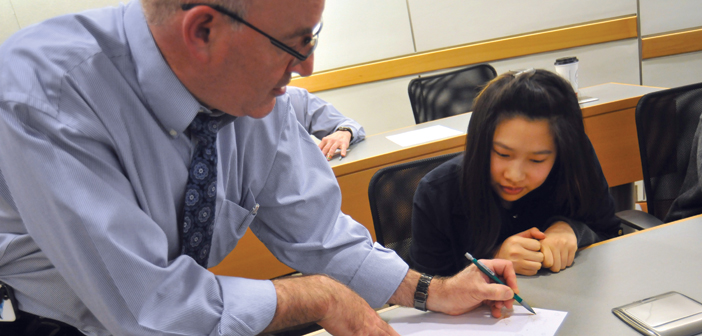An elective teaches art as a communication tool.
It’s not uncommon for a physician to grab a piece of scrap paper and sketch a complicated concept during a patient visit. The chambers of the heart, thyroid hormone synthesis—some are easier to illustrate than to explain verbally. A new elective last fall, “The Physician as Medical Illustrator,” aimed to help Alpert medical students improve those sketches.
Despite the name, course director François Luks, MD, professor of surgery, of pediatrics, and of obstetrics and gynecology, says the course wasn’t intended to turn medical students into professional illustrators. “It was meant to be news you can use. Not professional, but useful,” he says.
In six weeks, students learned the history of medical illustration, the rudiments of sketching and drawing (including perspective, shading, shadows, and texture), and how to best communicate medical and surgical concepts, including choice of point of view, level of complexity, and narrative aspects. Weekly drawing assignments were critiqued by the class. Arlet G. Kurkchubasche, MD, associate professor of surgery and of pediatrics, was course coleader, and Allegra Parrillo MD’18 was a student facilitator. About half of the students had no previous art experience. That led to some initial jitters. But, Luks says, “they quickly got over their hang-ups and did remarkable things.”
Aviya Lanis MD’18 started drawing in high school, and uses it to de-stress and embrace her right-brain creativity. “When I heard about this course, I was excited not only for a guaranteed time to allot to drawing but also for the opportunity to integrate [it]into everything we’ve been learning in class,” she says. “I was most surprised by the course leaders’ use of art in a typical consult with a patient, using basic diagrams to depict important concepts of processes going on in the body or procedures to be completed in surgery,” Lanis says. The class gave her an opportunity to develop such skills for her future patients, she adds.
The course culminated with a visit from Ian Suk, professor of neurosurgery and of art as applied to medicine at the Johns Hopkins University School of Medicine. Suk described his process of observing surgeries and anatomical dissections with neurosurgeons and then translating that into drawings that can serve as models for any patient’s individual anatomy. Luks hopes his course will develop into a larger collaboration with the Rhode Island School of Design. Through his work he’s discovered “latent needs in the institution” for illustration. “A RISD/Brown collaboration would serve them,” he says.




